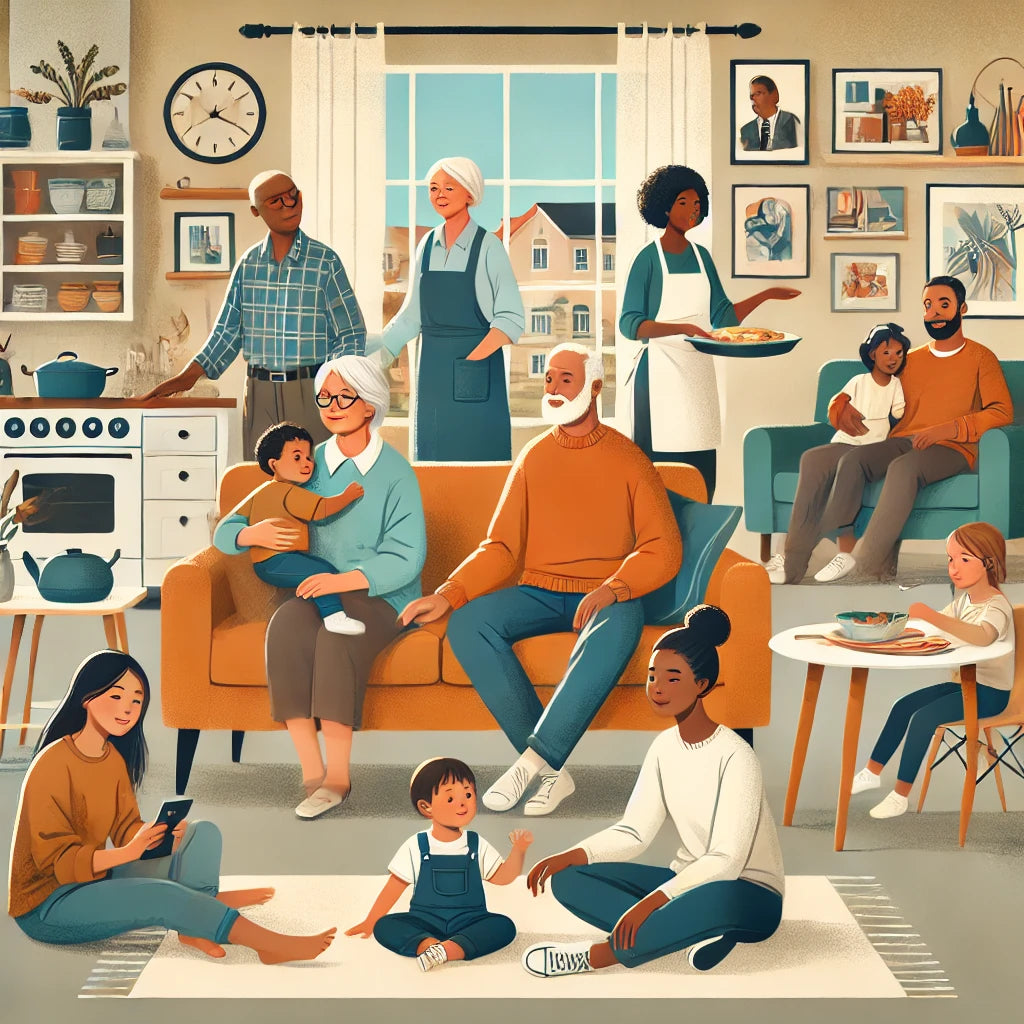
The Rise of Intergenerational Living: Benefits for Community and Well-Being
Intergenerational living is a concept that has seen a resurgence in recent years. This model, where multiple generations live under one roof or in close proximity, offers a multitude of benefits that extend beyond individual families to the broader community. This blog post explores the positive effects of intergenerational living, examining its historical context, modern resurgence, and impact on social, economic, and psychological well-being.
Historical Context and Modern Resurgence
Historical Roots
Intergenerational living was once the norm in many cultures worldwide. Before the industrial revolution, it was common for extended families to live together in the same household. This arrangement provided a support system where resources and responsibilities were shared among family members. The elderly were cared for by their children and grandchildren, while parents received help with childcare and household tasks.
Shift to Nuclear Families
The rise of industrialization and urbanization in the 19th and 20th centuries led to a shift towards nuclear family structures. Economic opportunities in urban centers often required families to move away from their extended relatives. This trend was further reinforced by the development of retirement homes and assisted living facilities, which became popular alternatives for elderly care.
Modern Resurgence
In recent years, there has been a resurgence of interest in intergenerational living. Several factors contribute to this renewed interest:
-
Economic Pressures: Rising housing costs and economic uncertainty have made intergenerational living an attractive option for many families.
-
Aging Population: As the global population ages, there is an increasing need for alternative living arrangements that provide support and care for the elderly.
-
Cultural Shifts: There is a growing recognition of the benefits of close family ties and community support systems.
Benefits of Intergenerational Living
1. Strengthening Family Bonds
One of the most significant benefits of intergenerational living is the strengthening of family bonds. When multiple generations live together, family members have more opportunities to interact and support each other. This can lead to stronger relationships and a greater sense of unity.
-
Shared Responsibilities: Tasks such as childcare, cooking, and household chores can be shared among family members, reducing the burden on any one individual.
-
Emotional Support: Living close to family provides a built-in support system, which can be particularly valuable during times of stress or crisis.
-
Cultural Continuity: Intergenerational living allows for the transmission of cultural traditions, values, and stories from older to younger generations, preserving cultural heritage.
2. Economic Benefits
Intergenerational living can offer significant economic advantages for families and communities.
-
Cost Savings: Sharing a household can reduce housing and utility costs. Families can save on expenses such as rent, mortgage payments, and home maintenance.
-
Shared Resources: Families can pool resources to purchase groceries, transportation, and other necessities, leading to overall cost savings.
-
Economic Stability: Intergenerational households can provide financial stability in times of economic uncertainty. For example, if one family member loses their job, others in the household can help support them until they find new employment.
3. Improved Health and Well-Being
Living in an intergenerational household can have positive effects on physical and mental health for individuals of all ages.
-
For Children: Children benefit from the presence of multiple caregivers who can provide attention, guidance, and support. This can lead to improved emotional and social development.
-
For Adults: Parents can receive help with childcare and household tasks, reducing stress and allowing for better work-life balance. Additionally, the emotional support provided by living close to family can improve mental health.
-
For the Elderly: Older adults benefit from increased social interaction and a sense of purpose. Being involved in family activities and helping with childcare can provide a sense of fulfillment and reduce feelings of loneliness and isolation.
4. Enhanced Social Capital
Intergenerational living can enhance social capital within communities. Social capital refers to the networks, relationships, and norms that facilitate cooperation and support within a community.
-
Community Engagement: Families living in intergenerational households are often more engaged in their communities. They are more likely to participate in community activities, volunteer, and support local organizations.
-
Knowledge Sharing: Older adults can share their knowledge and skills with younger generations, contributing to the overall well-being and development of the community.
-
Support Networks: Intergenerational living fosters strong support networks within communities. Neighbors are more likely to look out for each other and provide assistance when needed.
5. Environmental Sustainability
Intergenerational living can also contribute to environmental sustainability.
-
Resource Efficiency: Sharing a household reduces the consumption of resources such as energy, water, and building materials. This can lead to a smaller environmental footprint compared to living in separate households.
-
Sustainable Practices: Older generations often have knowledge of sustainable practices, such as gardening, composting, and reducing waste, which can be passed down to younger family members.
Case Studies and Examples
Co-Housing Communities
Co-housing communities are intentional communities where individuals and families live in private homes but share common spaces such as kitchens, gardens, and recreational areas. These communities are designed to foster social interaction and mutual support.
-
Case Study: Danish Co-Housing: Denmark has a long tradition of co-housing communities. Residents in these communities report high levels of social cohesion and mutual support. They share responsibilities such as cooking and childcare, creating a strong sense of community.
-
Case Study: Silver Sage Village: Located in Boulder, Colorado, Silver Sage Village is a co-housing community specifically designed for older adults. The community encourages intergenerational interaction by hosting events and activities that involve residents of all ages.
Multigenerational Housing Developments
Some housing developments are specifically designed to accommodate multiple generations within a single household.
-
Case Study: Lennar’s Next Gen® Homes: Lennar, a leading homebuilder, offers a line of homes called Next Gen® – The Home Within a Home®. These homes feature separate living spaces for extended family members, providing privacy while fostering close family ties.
-
Case Study: UK Multigenerational Living: In the UK, housing developments such as New Ground Co-Housing in London are designed to accommodate multigenerational living. These developments include features such as shared gardens, communal spaces, and adaptable living units.
Intergenerational Programs
Many communities and organizations have implemented programs to promote intergenerational interaction and support.
-
Case Study: Generations United: Generations United is a nonprofit organization that promotes intergenerational collaboration. They offer programs such as Grandfamilies, which supports grandparents raising grandchildren, and Young and Old Together, which connects older adults with young people in community activities.
-
Case Study: Intergenerational Learning Centers: Intergenerational learning centers, such as the ONEgeneration Daycare in Los Angeles, provide opportunities for young children and older adults to interact and learn from each other. These centers offer programs that involve shared activities, such as storytelling, gardening, and arts and crafts.
Challenges and Considerations
While intergenerational living offers many benefits, it is not without its challenges. It is essential to consider these challenges and find ways to address them to ensure successful and harmonious living arrangements.
1. Privacy and Personal Space
One of the main challenges of intergenerational living is ensuring that all family members have adequate privacy and personal space.
-
Design Solutions: Thoughtful home design can help address this issue. Separate living areas, such as in-law suites or separate entrances, can provide privacy while still allowing for close family interaction.
-
Communication: Open and honest communication about boundaries and personal space is essential. Family members should discuss their needs and come to mutually agreeable solutions.
2. Interpersonal Conflicts
Living in close quarters with family members can sometimes lead to interpersonal conflicts.
-
Conflict Resolution: Implementing conflict resolution strategies, such as active listening, empathy, and compromise, can help manage and resolve conflicts.
-
Professional Help: In some cases, seeking the help of a family therapist or counselor can provide valuable support and guidance.
3. Financial Strain
While intergenerational living can offer economic benefits, it can also lead to financial strain if not managed carefully.
-
Financial Planning: It is essential to have a clear financial plan that outlines how expenses will be shared and managed. This plan should be regularly reviewed and adjusted as needed.
-
Resource Management: Families should be mindful of resource management and look for ways to reduce costs, such as bulk purchasing or energy-saving measures.
Conclusion
Intergenerational living is a powerful model that offers numerous benefits for families and communities. By fostering strong family bonds, providing economic advantages, improving health and well-being, enhancing social capital, and contributing to environmental sustainability, intergenerational living can create more resilient and supportive communities.
As society continues to face challenges such as economic uncertainty, an aging population, and environmental concerns, intergenerational living presents a viable and beneficial solution. By embracing this model and addressing its challenges, we can build stronger, more connected communities that support the well-being of all generations.
Intergenerational living is not just about sharing a household; it is about creating a culture of care, support, and mutual respect that transcends age and fosters a sense of belonging for everyone. Whether through co-housing communities, multigenerational housing developments, or intergenerational programs, the potential for positive impact is immense. It is time to recognize and harness the power of intergenerational living to build a brighter and more inclusive future.
xoxoxo
-The Not So Common Gal
